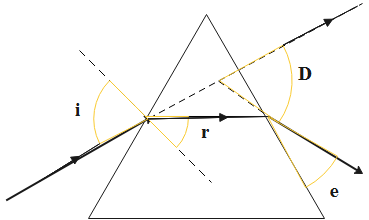
Light is incident from the glass \[(\mu =1.5)\] side on the interface of glass and air. Find the angle of incidence for which the angle of deviation is \[90{}^\circ \].
Answer
565.8k+ views
Hint: Firstly, we will find the value of the critical angle using the refractive index value given. Then, will find the value of the maximum attainable deviation using this critical angle. Based on the value of the maximum attainable deviation, we will find the value of the angle of incidence. In this case, total internal reflection takes place, as the angle of deviation is \[90{}^\circ \], thus the angle of incidence equals half the value of the angle of deviation.
Formula used:
\[\sin \,C=\dfrac{1}{\mu }\]
Complete answer:
The relation between the angle of incidence (i), the angle of refraction (r), the angle of emergence (e) and the angle of deviation (D).

As the refractive index is \[\mu =1.5\].
So, the critical angle is given as follows.
\[\sin \,C=\dfrac{1}{\mu }\]
Substitute the given value of the refractive index in the above equation.
\[\begin{align}
& \sin \,C=\dfrac{1}{1.5} \\
& \Rightarrow C={{\sin }^{-1}}\left( \dfrac{1}{1.5} \right) \\
\end{align}\]
Continue the further calculation to obtain the value of the critical angle.
\[\begin{align}
& C={{\sin }^{-1}}\left( 0.667 \right) \\
& \Rightarrow C=41.81{}^\circ \\
\end{align}\]
The conditions for the maximum deviation to take place are as follows.
When the angle of incidence equals the value of \[90{}^\circ \], the maximum deviation takes place and in this case, the angle of incidence is called the grazing incidence.
After leaving the prism, if the emergent light grazes along the prism surface, then the maximum deviation can be attained.
In the case of the refraction, the maximum attainable deviation is given as follows.
\[{{\delta }_{\max }}=90{}^\circ -C\]
Substitute the obtained value of the critical angle in the above equation.
\[\begin{align}
& {{\delta }_{\max }}=90{}^\circ -41.8{}^\circ \\
& \Rightarrow {{\delta }_{\max }}=48.18{}^\circ \\
\end{align}\]
The given angle of deviation is\[90{}^\circ \], but the maximum angle of deviation is \[48.18{}^\circ \]. Thus, the total internal reflection must take place in this case.
The deviation in the case of reflection is given as follows.
\[\begin{align}
& \Delta =180{}^\circ -2i \\
& \Rightarrow 180{}^\circ -2i=90{}^\circ \\
\end{align}\]
Continue further calculation.
\[\begin{align}
& 180{}^\circ -90{}^\circ =2i \\
& \Rightarrow i=45{}^\circ \\
\end{align}\]
Therefore, the value of the angle of incidence obtained equals \[45{}^\circ \] for which the angle of deviation is \[90{}^\circ \].
Note:
The value of the angle of incidence depends on the value of the maximum angle of deviation attained. The conditions for the maximum deviation discussed above should also be known to solve such problems.
Formula used:
\[\sin \,C=\dfrac{1}{\mu }\]
Complete answer:
The relation between the angle of incidence (i), the angle of refraction (r), the angle of emergence (e) and the angle of deviation (D).

As the refractive index is \[\mu =1.5\].
So, the critical angle is given as follows.
\[\sin \,C=\dfrac{1}{\mu }\]
Substitute the given value of the refractive index in the above equation.
\[\begin{align}
& \sin \,C=\dfrac{1}{1.5} \\
& \Rightarrow C={{\sin }^{-1}}\left( \dfrac{1}{1.5} \right) \\
\end{align}\]
Continue the further calculation to obtain the value of the critical angle.
\[\begin{align}
& C={{\sin }^{-1}}\left( 0.667 \right) \\
& \Rightarrow C=41.81{}^\circ \\
\end{align}\]
The conditions for the maximum deviation to take place are as follows.
When the angle of incidence equals the value of \[90{}^\circ \], the maximum deviation takes place and in this case, the angle of incidence is called the grazing incidence.
After leaving the prism, if the emergent light grazes along the prism surface, then the maximum deviation can be attained.
In the case of the refraction, the maximum attainable deviation is given as follows.
\[{{\delta }_{\max }}=90{}^\circ -C\]
Substitute the obtained value of the critical angle in the above equation.
\[\begin{align}
& {{\delta }_{\max }}=90{}^\circ -41.8{}^\circ \\
& \Rightarrow {{\delta }_{\max }}=48.18{}^\circ \\
\end{align}\]
The given angle of deviation is\[90{}^\circ \], but the maximum angle of deviation is \[48.18{}^\circ \]. Thus, the total internal reflection must take place in this case.
The deviation in the case of reflection is given as follows.
\[\begin{align}
& \Delta =180{}^\circ -2i \\
& \Rightarrow 180{}^\circ -2i=90{}^\circ \\
\end{align}\]
Continue further calculation.
\[\begin{align}
& 180{}^\circ -90{}^\circ =2i \\
& \Rightarrow i=45{}^\circ \\
\end{align}\]
Therefore, the value of the angle of incidence obtained equals \[45{}^\circ \] for which the angle of deviation is \[90{}^\circ \].
Note:
The value of the angle of incidence depends on the value of the maximum angle of deviation attained. The conditions for the maximum deviation discussed above should also be known to solve such problems.
Recently Updated Pages
Master Class 12 Business Studies: Engaging Questions & Answers for Success

Master Class 12 Economics: Engaging Questions & Answers for Success

Master Class 12 English: Engaging Questions & Answers for Success

Master Class 12 Maths: Engaging Questions & Answers for Success

Master Class 12 Social Science: Engaging Questions & Answers for Success

Master Class 12 Chemistry: Engaging Questions & Answers for Success

Trending doubts
What are the major means of transport Explain each class 12 social science CBSE

Which are the Top 10 Largest Countries of the World?

Draw a labelled sketch of the human eye class 12 physics CBSE

Explain sex determination in humans with line diag class 12 biology CBSE

The pH of the pancreatic juice is A 64 B 86 C 120 D class 12 biology CBSE

Give 10 examples of unisexual and bisexual flowers




